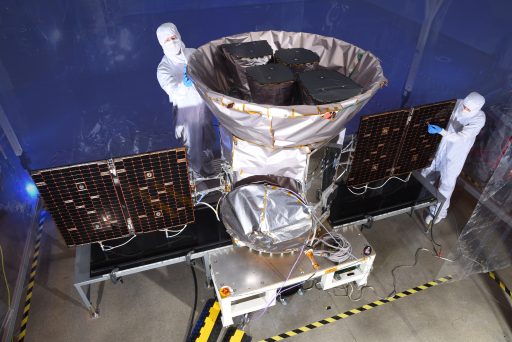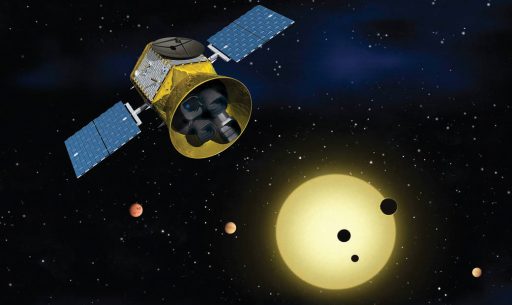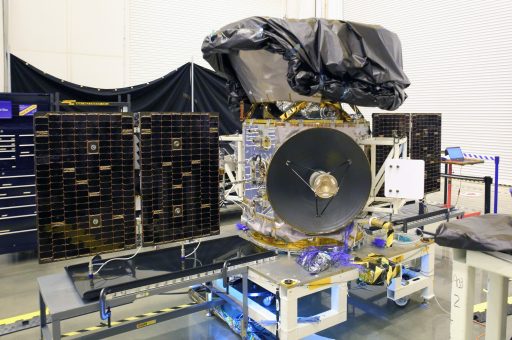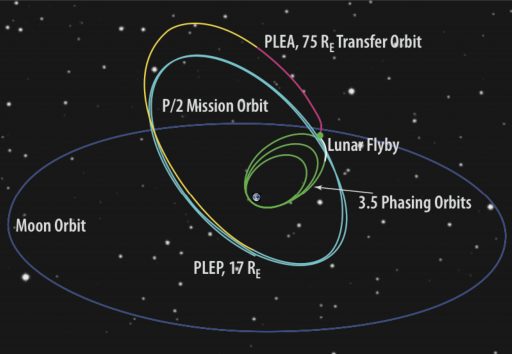TESS – Transiting Exoplanet Survey Satellite

The Transiting Exoplanet Survey Satellite is an expoplanet space telescope operated by NASA and MIT to conduct a comprehensive survey of the brightest stars near Earth for the detection of exoplanets through the transit method. Operating from a highly elliptical high-Earth orbit,
TESS will perform a mission of at least two years – operating a package of four Wide Field Cameras tasked with obtaining the first-ever spaceborne exoplanet all-sky survey to a) detect exoplanet candidates and b) collect valuable information such as mass, size, density and orbit of a large number of currently known and unknown exoplanets with special focus on those in the habitable zone around their host stars.
Previous all-sky surveys using ground based telescopes were mostly limited to the detection of giant exoplanets that are usually not suitable for harboring life. With TESS, detection will be possible for a large number of small planets around the brightest stars in the sky. To that end, TESS is considered an extremely valuable precursor mission to the James Webb Space Telescope, assembling a list of observation targets for further study by the upcoming flagship mission.

TESS is flying under NASA’s Explorers Program that provides flight opportunities to inexpensive missions in the form of small spacecraft and hosted payloads covering a diverse field of scientific branches including geophysics, heliophysics and astrophysics. As a Medium-Class Explorers Mission (MIDEX), TESS has a budget of $243 million.
The TESS Project started out in 2006 at the Massachusetts Institute of Technology and was supported through private funding by Google and The Kavli Foundation. MIT submitted a mission proposal for TESS in 2008 under the Small Explorers program led by NASA’s Goddard Space Flight Center but the mission was not selected. It was re-submitted in 2010 under the Explorers Program and downselected to 11 proposals that received funding to enter a more advanced stage of development. TESS was selected by NASA in 2013 along with the NICER astrophysics payload headed to the International Space Station.

Over the course of its mission, TESS will monitor the brightness of approximately 200,000 stars and is expected to detect more than 1,500 transiting exoplanets including a large sample of around 500 Earth-sized and Super Earth planets. TESS will detect a large variety of rock-and-ice planets in orbit around a diverse set of stellar types and cover a broad range of orbital periods. A number of Earth-sized planets in the habitable zone around their host will likely be detected by TESS and scrutinized with current and future ground- and space-based assets to study their atmospheres.
Under the TESS Project, MIT is responsible for the scientific instrument, Orbital ATK builds and operates the spacecraft, NASA Goddard provides project management, systems engineering and mission assurance, and Science Center responsibilities like data analysis and archiving are handled by a partnership between MIT, the Kavli Institute, the Smithsonian Astrophysical Observatory and NASA’s Ames Research Center.

Although much smaller and with a lighter budget than NASA’s Kepler exoplanet hunter, TESS will deliver not only complementary measurements but expand Kepler’s catalog. Stars observed by the 360-Kilogram spacecraft will be 30 to 100 times brighter than those observed by Kepler which will make follow-on characterization of exoplanet atmospheres and other properties much easier.
TESS is hoped to leave a legacy of a large catalog of the nearest and brightest stars hosting exoplanets to keep the scientific community busy for years to come. Unlike Kepler that cataloged mostly faraway stars, TESS will focus on easy-to-study exoplanets in Earth’s astronomical neighborhood – covering G, K and M-type stars with optical magnitudes brighter than Mag 12.
The TESS mission will cover an area of the sky 400 times larger than that covered by Kepler, its data will allow for a determination of exoplanet mass, radius and orbit, and observations will also provide insight into planet-to-planet interactions, tides and the presence of moons.

The mission sets out to conduct a systematic survey of the sky via 26 observation sectors of 24 x 96 degrees with 27 days of observations allocated for each sector over the primary mission. Observations of the brightest stars will be collected at a cadence of two minutes and full frame imagery will be collected at 30-minute cadence. Additionally, the mission’s design has been set up to cover the Southern Hemisphere in the first year and the Northern Hemisphere in the second year with some overlap at the ecliptic poles to increase sensitivity for smaller / longer-duration planets that fall within the Continuous Viewing Zone of the JWST mission.
The TESS mission will utilize an orbit that has never been used before, known as a 2:1 lunar resonant orbit (P/2) of 108,000 by 376,000 Kilometers, inclined 37 degrees to either side of the equator with a period of half a lunar day (13.7 days). This orbit remains entirely above the Earth’s radiation belts to place TESS in a low-dose environment with a total ionizing dose of under 1 krad over the primary mission while also subjecting the spacecraft and its cameras to a nearly constant thermal environment to allow the detectors to experience temperature violations of no more than 0.1K/hr for over 90% of the orbit.

The P/2 orbit for TESS has been designed to position the apogee 90° away from the Moon’s in order to minimize its destabilizing effect. Setting up the operational orbit will require TESS to be injected into an initial elliptical transfer orbit by the launch vehicle followed by adjustments through its onboard propulsion system and a critical lunar flyby.
The operational orbit has been simulated extensively to ensure TESS can remain in a stable orbit for long periods of time without excessive propellant expenditure. Numerical simulations showed the orbit will be subject to a long-term exchange between eccentricity and inclination at a periodicity of 6 to 12 years while short-term oscillations on the order of six months will be caused by solar perturbations. Otherwise, the orbit has shown to be very stable with no stationkeeping requirements over a period of at least two decades.
The primary factor in selecting a P/2 orbit for TESS was that it offers very long and unbroken observation opportunities of over 300 hours per orbit, a very stable thermal environment, a stray light environment orders of magnitude lower than that found in low Earth orbit, low radiation levels outside the Van Allen Belts, excellent pointing stability due to insignificant gravity gradients and a simple operational mission scheme. Typical operations of the satellite call for only one downlink session per orbit, approx. 4 hours in duration around the perigee passage where data rates are highest at 100Mbit/s followed by a single re-point maneuver and resumption of a two-week observation arc.
